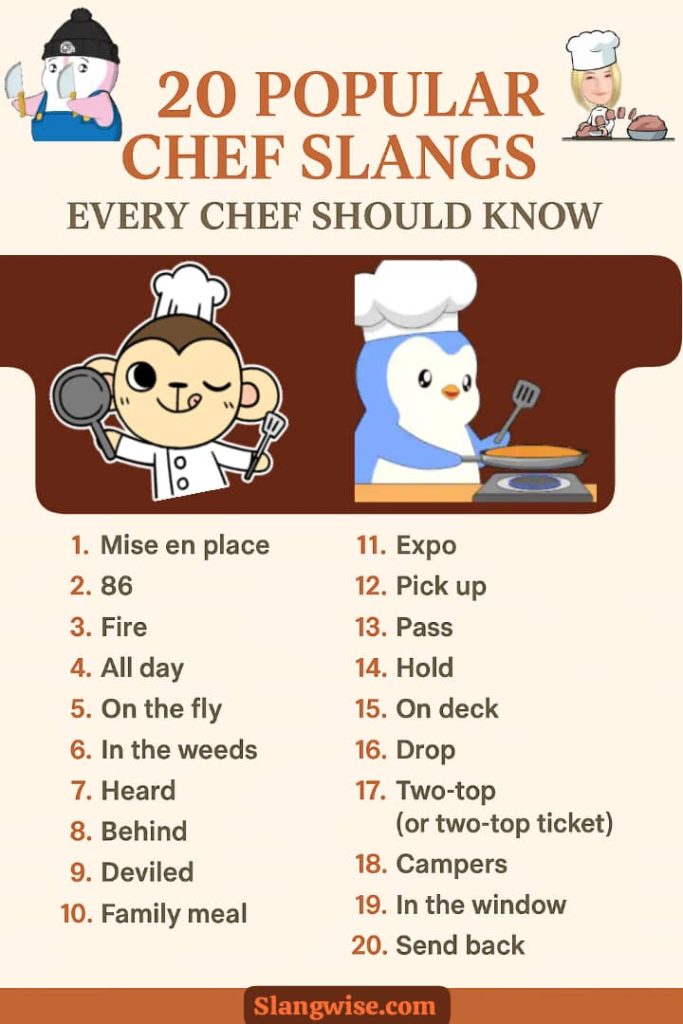Restaurant kitchens run on precision, speed, and teamwork. Chef slang evolved to shave precious seconds off orders, prevent mistakes, and keep the brigade in sync.
Below are twenty popular slang terms that every chef, and kitchen newcomer, should know, along with what they really mean and how to use them.

Table of Contents
Chef’s Slangs In a nutshell
- Kitchen code streamlines communication: grasping slang boosts speed and clarity.
- Prep terms like mise en place set the stage for smooth service.
- Order signals such as “86,” “fire,” and “on the fly” keep the line moving.
- Status updates like “in the weeds” or “heard” help teams coordinate under pressure.
SlangWise Tip: “Speak the kitchen’s language, every phrase saved is a second earned.”
20 Popular Chef Slangs Every Chefs Should Know
1. Mise en place
“Everything in its place.”
Mise en place in chef’s slang is the practice of prepping and arranging ingredients and tools before service begins. This includes chopping vegetables, measuring spices, and setting up pans.
A well-executed mise en place ensures chefs don’t scramble for ingredients during peak hours, maintaining flow and consistency.
For more on this cornerstone concept, see the Culinary Institute of America’s guide on mise en place and its role in professional kitchens.
For instance: “Station is set, mise en place is complete. Ready to open.”
2. 86
“We’re out of it,” or “Cut that item from the menu.”
86 in chefs word means to cancel an item because it’s sold out or unavailable.
Signaling an “86” quickly prevents servers from taking orders for an out-of-stock dish, avoiding guest disappointment and wasted labor.
This term’s murky origins may trace back to old diner codes or 1930s soda fountains, but it remains universal in modern kitchens.
Example: “86 the salmon, pan fried is sold out.”
3. Fire
“Start cooking it now.”
Fire is the command to put an order into the cooking process.
“Firing” keeps the line synchronized; every station knows when to begin their portion of the dish.
Often paired with “behind” to maintain safety: “Behind, two steaks firing.”
For xample: “Two steaks fire on my mark, ready?”
4. All day
“Total count of a particular dish needed right now.”
The cumulative number of identical items required, combining new and existing orders.
Instead of adding orders by station, a chef yells “four risottos all day” to clarify total demand, minimizing miscounts.
A clear “all day” count prevents over- or under-cooking during busy service.
Usage: “Salads all day: three.”
Read Also: 7 most controversial slang words in sports and why leagues wants them banned.
5. On the fly
“Rush this order.”
On the fly in chefs slang measns to prioritize an order outside the normal sequence, typically because of a special request or time constraint.
Why it matters: “On the fly” alerts stations to expedite without disrupting the overall flow.
Use sparingly to avoid overwhelming the line.
Instance: “Burger on the fly, table seven is in a hurry.”
6. In the weeds
“Overwhelmed by orders or tasks.”
When a chef or station falls behind and struggles to keep up. Recognizing “weeds” signals teammates to offer help before service quality slips.
A quick team huddle can pull the station out of the weeds and back on track.
For instance: “Expo, we’re in the weeds, need two hands on garnish.”
7. Heard
“Order received and understood.”
Heard is an Acknowledgment that an order or instruction has been noted.
It Prevents repeated calls and miscommunication. When a line cook yells “heard!” after an order, it confirms clarity.
Maintaining this call-and-response keeps the brigade efficient.
For Instances:
- Chef: “Two medium-rare lamb chops.”
- Cook: “Heard.”
8. Behind
“Warning that someone is passing through.”
Behind is a safety call to alert staff when carrying hot plates, pans, or sharp objects behind someone. Kitchen spaces are cramped; a quick “behind!” prevents collisions and injuries.
Use it whenever crossing behind a teammate to uphold a safe work environment.
For Example : “Behind with a hot pan!”
9. Deviled
“To dress with spices, sauces, or breadcrumbs.”
Deviled in kitchen slang often applied to eggs (deviled eggs), fish (deviling fish), or other proteins by coating them with seasoned breadcrumbs or a spicy sauce.
Adds texture and flavor. Calling for something to be “deviled” ensures a consistent, elevated finish.
The term dates back to 18th-century England and speaks to adding heat or zest.
Usage: “Devil the fish with chili aioli.”
10. Family meal
“Staff meal prepared and eaten together before or after service.”
A collective meal for kitchen and front-of-house staff, often using leftover ingredients is termed family meal in kitchen slang.
It builds camaraderie, rewards long hours, and reduces waste by repurposing unused items.
It’s a cherished ritual that unites the team and boosts morale.
For example: “Family meal at 4:15; seafood pasta.”
11. Expo
“The conductor of the pass.”
Expo is hhort for expediter: the person who organizes finished dishes, checks plating, times courses, and sends food to the dining room.
The expo is the quality control point. A strong expo prevents cold plates, missing garnishes, and confused servers.
For example: “Expo, two steaks need new jus and a side, ready to send?”
12. Pick up
“Take it to the dining room.”
Notification that a plate or ticket is ready for the server to collect. Often shouted when the server approaches the pass.
Clear “pick up” calls keep the service flow moving and avoid bottlenecks at the pass.
Usage example: “Pick up: table 12, salmon medium.”
13. Pass
“The shelf between the line and the servers.”
Pass in slang is the area where finished dishes are placed for servers to collect. Also used as a verb, to place a plate on the pass. The pass is the hand-off zone. Respecting its rhythm keeps food hot and orders accurate.
Example: “Put the risotto on the pass, expo will hit it.”
14. Hold
“Delay serving this dish.”
Hold is chefs instruction to keep a plate from going out until further notice: often used for timing courses or synchronizing a table’s meals. Proper holds ensure all guests at a table are served together and courses arrive in the right order.
For example: “Hold table 9’s mains, desserts are still running.”
15. On deck
“Next up.”
An item that should be prepared soon because it’s the next ticket in line. Similar to being “ready to go.”
Calling something “on deck” helps stations prepare without rushing, improving timing and consistency.
Usage: “Chicken on deck, start the sauce in two minutes.”
16. Drop
“Put it in the fryer or start cooking.”
To place food into cooking equipment, most commonly the fryer. “Drop” signals the beginning of a timed cook. Timing matters in frying; a clear “drop” call prevents over- or undercooking and helps coordinate sides and accompaniments.
Example: “Drop fries, two minutes.”
17. Two-top (or two-top ticket)
“An order for a table of two.”
Two-top is a shorthand for the size of the party the order belongs to, two-top (2), four-top (4), etc. Kitchens use this to prioritize and plate for the correct table size.
Why it matters: Knowing table size helps with portioning, plating, and timing, especially for shared plates or family-style items.
For Instance: “Two-top, steak and salad, server is at the pass.”
18. Campers
“Plates that linger on the pass.”
Campers means dishes that sit on the pass too long before being picked up by servers. Often called out to urge servers to collect them.
Campers cool down and lose quality. Calling or clearing campers keeps food hot and service moving.
Usage: “Clear the campers, four plates sitting.”
19. In the window
“Ready and waiting under the heat lamp.”
In the window indicates a dish is finished and placed in the heated holding area (the “window”) for servers to collect.
Communicates that a plate is fully finished and awaiting pickup; helps coordinate pick-up timing when the dining room is busy.
Usage example: “Table 6 entrees in the window, pick up.”
20. Send back
“Redo or correct this dish.”
When a guest returns a plate because it’s incorrect, under/overcooked, or otherwise unsatisfactory. The kitchen is instructed to fix or remake it.
Handling send-backs quickly and professionally preserves guest experience and maintains service rhythm. Clear reasons avoid repeat errors.
Usage example: “Send back: chicken was raw, re-fire and check temp.”
Final Thought
Mastering these twenty slang words equips chefs with a linguistic toolkit to communicate quickly, reduce errors, and foster teamwork. From prepping your station (mise en place) to knowing when you’re in the weeds, each phrase carries weight in a high-pressure environment.
By integrating these terms into daily service and studying more on their origins on Wikipedia’s culinary glossary and the American Culinary Federation at acfchefs.org, kitchen crews can operate like a well-oiled machine, and deliver exceptional dining experiences night after night.

